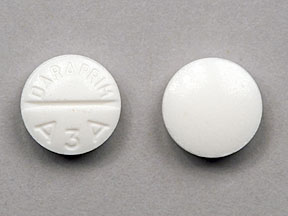Daraprim Disease Interactions
There are 4 disease interactions with Daraprim (pyrimethamine).
Pyrimethamine (applies to Daraprim) folate deficiency
Major Potential Hazard, High plausibility. Applicable conditions: Malabsorption Syndrome, Acute Alcohol Intoxication, Anemia Associated with Folate Deficiency
Pyrimethamine is a folate antagonist. The use of pyrimethamine is contraindicated in patients with megaloblastic anemia caused by folate deficiency. Pyrimethamine should be used with caution in patients with malabsorption syndrome, alcoholism, pregnancy, and in those receiving other folate depleting drugs. Monitoring CBCs and platelet counts are recommended. If signs of folic acid deficiency occur, the drug dosage should be reduced or discontinued. Leucovorin may need to be administered to reverse folic acid deficiency.
Pyrimethamine (applies to Daraprim) liver disease
Moderate Potential Hazard, Moderate plausibility.
Pyrimethamine is extensively metabolized by the liver. Therapy with pyrimethamine should be administered cautiously in patients with liver disease.
Pyrimethamine (applies to Daraprim) renal dysfunction
Moderate Potential Hazard, Moderate plausibility.
Pyrimethamine and its metabolites are excreted in the urine. Therapy with pyrimethamine should be administered cautiously in patients with renal dysfunction.
Pyrimethamine (applies to Daraprim) seizure disorders
Moderate Potential Hazard, High plausibility. Applicable conditions: Seizures
The use of pyrimethamine has been associated with ataxia, tremors, and seizures. Therapy with pyrimethamine should be administered cautiously and in lower dosages in patients with seizure disorders.
Switch to professional interaction data
Daraprim drug interactions
There are 30 drug interactions with Daraprim (pyrimethamine).
More about Daraprim (pyrimethamine)
- Daraprim consumer information
- Check interactions
- Compare alternatives
- Pricing & coupons
- Reviews (1)
- Drug images
- Side effects
- Dosage information
- During pregnancy
- Generic availability
- Drug class: miscellaneous antimalarials
- Breastfeeding
- En español
Related treatment guides
Drug Interaction Classification
| Highly clinically significant. Avoid combinations; the risk of the interaction outweighs the benefit. | |
| Moderately clinically significant. Usually avoid combinations; use it only under special circumstances. | |
| Minimally clinically significant. Minimize risk; assess risk and consider an alternative drug, take steps to circumvent the interaction risk and/or institute a monitoring plan. | |
| No interaction information available. |
See also:
Further information
Always consult your healthcare provider to ensure the information displayed on this page applies to your personal circumstances.


